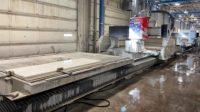Engineered stone is a sought-after material. Its durable and eye-catching design makes it popular for kitchen countertops, floors and more. Engineered stone is often less expensive than natural stone and, as the name suggests, “engineered” to the customer’s liking – meaning nonporous slabs that are consistent in shape and color.
And the market continues to evolve, with new trends popping up as others die out. Granite is no longer the stone du jour and consumers’ desire for customizable finishes is constantly changing.
Here are three trends we are seeing in engineered stone – and how waterjet’s versatility can bring them to life.
Quartz Reigns Supreme
In recent years, it seems that quartz is the new go-to for kitchen countertops. Thanks to its non-porous surface, quartz is easy to clean and provides uniformity in color and texture. It also allows many options for buyers when it comes to design and shape. Engineered quartz contains roughly 90 percent of quartz rock itself, while the rest of the material is made up of different pigments and resins.
But it’s not just its aesthetic options that make engineered quartz popular. The material is also heat resistant and extremely durable, able to withstand acidic substances and the day-to-day work that’s done in the kitchen.
Like quartz, Dekton is another favorite among engineered stone. Dekton is created through a process that exposes the materials’ particles to extreme heat and pressure – simulating the transformation that natural stone goes through over thousands of years. Dekton’s durability and style make it a popular material for kitchen countertops and islands.
Where Does Waterjet Fit in to the Mix?
Waterjet’s versatility allows it to cut natural or engineered stone with precision. Abrasive waterjet technology can effectively cut through stone and requires minimal finishing. It’s also a great option due to its ability to make intricate cuts for those looking to create complicated inlays or edges.
Getting the Edge
When preparing a custom countertop, choosing your material is the first step. From there, it’s time to decide on a finish. Countertops, vanities and other surfaces come in a variety of shapes and sizes. They also pose the question: What kind of edge do you want?
Waterfall edges are on-trend, offering an updated look that can make any kitchen pop. These edges extend beyond the top of a surface and continue down the side of a countertop. The name comes from the idea that the material “falls” beyond the countertop and onto the floor. They’re also known as mitered edges, which consist of two slabs cut at 45 degrees that meet at a 90-degree angle.
With cutting technology like the Pivot+ cutting head, waterjet is ideal for creating beveled or mitered edges for countertops and allows you to get the job done fast with no chipping or breakage and with minimal kerf.
Beyond Countertops
While countertops are a popular application for engineered stone, there’s a lot more you can create with quartz or other synthetic materials. Flooring, shelves, mantles and shower backsplashes are all potential projects.
Quartz and other synthetic stone can also be used as an inlay on various surfaces, adding a sleek pop of design. The popularity of engineered stone will continue to grow – and its durability and color options make it an even more attractive option for interior decorating.
Engineered stone floors, for example, can withstand a lot – they are hard to chip or stain and require little maintenance. They also nicely complement quartz countertops or tables.
Abrasive waterjet doesn’t produce any heat or surface stress on engineered stone finishes, making it a great tool for a variety of projects. Waterjet’s omnidirectional cutting allows users to create intricate inlays and designs, too. No matter the application, waterjet’s adaptability can get just about any stone-cutting job done with precision.




